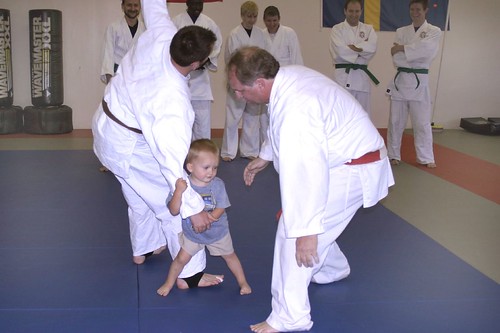Basic principles for Judo throws.
 Judo is all about application of principles, as a parent you can understand the principles without having applied them yourself.
Judo is all about application of principles, as a parent you can understand the principles without having applied them yourself.
As such, you can help your child learn to throw better even if you have never done Judo.
In this post, we shall outline some fundamental principles of Judo standing work and throwing. If you can understand these ideasand help your child to understand or at least apply them, their Judo will improve.
Balance
Balance is the key to Judo. If you child is on balance they can not be thrown… at least until their balance is broken. So you want to ensure that your child stands in a balanced posture. This generally means standing upright not bent over pushing and pulling. They want to be in a posture that would be comfortable and maintainable if their partner disapeared suddenly.
Breaking Balance
Before any throw will work your child needs to break their partners balance. Once they are off balance, your child can throw them in the direction they are off balance.
A common way to break the balance is with movement. If your child moves backwards, their partner will need to move forward to prevent themselves being taken off balance. If your child moves backwards and quickly turns 180 degrees and drops their weight, their partner will be off balance and fall forwards over your child. At this point your child is throwing with Seoi Nage.
Levers (seesaws)
Back in school you will remember learning about levers, about fulcrums and that sort of thing. A principle of many throws is the use of levers and turning yourself into the fulcrum around which your opponent rotates/falls.
In the throw discussed above (Seoi Nage), your child takes the partner off balance by moving backwards. They then rotate 180 degrees and lower their body, so that their hips are low. When they throw, bending forwards, their hips act as a fulcrum.
Imagine your child and their opponent as a seesaw, your childs hips is the center axle, the partner the plank.
If your child does not lower their hips low enough, then imagine a lopsided seesaw, it will be hard to throw. If they drop low enough, forces are equal and it will be easy to throw. Drop slightly lower and the partner may be top heavy and throwing will be even easier.
Mum/Dad as coach.
As you can see from the above text, it’s pretty simple to see when your child has not gone low enough. Seeing when the partner is not off balance is harder but often easily seen from off the mat.
As a parent, you can coach your child (when and as appropriate); by watching for mis-application of principles. In the example we have been using in this post you can coach your child be observing the following points:
- Moving backwards to break balance
- 180 degree rotation
- Lowering of body/hips to act as fulcrum
If you notice that your child is not doing one of these things, you can help encourage them to do them. Especially if you are practising in the living room. If it is a club situation, best leave the coaching to the club coach normally.
🙂